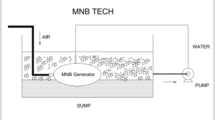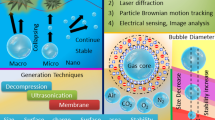Abstract
Nanobubbles (NBs) have potential properties, are environmentally friendly, and are sustainable to be used in a variety of applications: industries, agriculture, medical technology, and engineering applications such as water/wastewater treatment. This paper focuses on improving the characteristics of municipal secondary effluent (SE) utilizing oxygen bubbles (OBs), conventional coarse air bubbles (ABs), oxygen nanobubbles (ONBs), and air nanobubbles (ANBs). NBs were generated by injecting pressured gases through a tubular ceramic membrane with nanopores. Several tests have been used to determine the quality of tested SE before and after different injection times, including dissolved oxygen concentration (DO), pH, chemical oxygen demand (COD), biochemical oxygen demand (BOD5), total dissolved solids (TDS), total suspended solids (TSS), sulfide, orthophosphate, organic nitrogen, ammonia, oil and grease, and Escherichia coli (E. coli). The results show the priority of ONBs in the enhancement of SE quality. For example, after injecting ONBs, OBs, ANBs, and ABs in SE, the TSS was reduced by 57%, 42%, 28% and 14%, the COD by 62%, 41%, 26% and 12%, the BOD5 by 73%, 56%, 43% and 21%, and the organic nitrogen decreased by 19%, 11% and increased by 14% and 9%, respectively. These findings are intended to grasp the gaps in our understanding of how NBs affect the advanced treatment of SE.
Highlights
-
The use of nanobubbles to enhance secondary effluent was investigated.
-
Oxygen nanobubbles result in an eightfold increase in the level of dissolved oxygen.
-
Oil and grease content is decreased by 33% with oxygen nanobubbles.
-
Escherichia coli is decreased by 94% due to free radicals of nanobubbles collapse.















Similar content being viewed by others
Data Availability
The datasets generated during and/or analyzed during the current study are available from the corresponding author.
References
Abate B, Valverde J (2017) Reduction of thermotolerant coliforms present in the sea water by means of micro-nanobubbles of air-ozone of the beach Los Pavos, Lima, Peru. Chem Eng Trans 60:313–318
Abdella AK, Elmageed HAE, Abdel-Aa MH (2021) Iron removal from ground water through expanded polystyrene filter. J Environ Treatment Tech 9(3):657–666
Agarwal A, Ng WJ, Liu Y (2011) Principle and applications of microbubble and nanobubble technology for water treatment. Chemosphere 84(9):1175–1180. https://doi.org/10.1016/j.chemosphere.2011.05.054
Ahmadi M, Nabi Bidhendi G, Torabian A et al (2018) Effects of nanobubble aeration in oxygen transfer efficiency and sludge production in wastewater biological treatment. J Adv Environ Health Res 6(4):225–233. https://doi.org/10.22102/jaehr.2018.135459.1086
Ahmed AKA, Sun C, Hua L et al (2018a) Generation of nanobubbles by ceramic membrane filters: the dependence of bubble size and zeta potential on surface coating, pore size and injected gas pressure. Chemosphere 203:327–335. https://doi.org/10.1016/j.chemosphere.2018.03.157
Ahmed AKA, Sun C, Hua L et al (2018b) Colloidal properties of air, oxygen, and nitrogen nanobubbles in water: effects of ionic strength, natural organic matters, and surfactants. Environ Eng Sci 35(7):720–727. https://doi.org/10.1089/ees.2017.0377
Ahmed AKA, Shalaby M, Negim O, Abdel-Wahed T (2022) Comparative study of the Egyptian code for reusing treated wastewater for agriculture. Sohag Eng J 2(1):1–14. https://doi.org/10.21608/sej.2022.115242.1006
An J, Li N, Zhao Q et al (2019) Highly efficient electro-generation of H2O2 by adjusting liquid-gas-solid three phase interfaces of porous carbonaceous cathode during oxygen reduction reaction. Water Res 164:114933. https://doi.org/10.1016/j.watres.2019.114933
Atkinson AJ, Apul OG, Schneider O et al (2019) Nanobubble technologies offer opportunities to improve water treatment. Acc Chem Res 52(5):1196–1205. https://doi.org/10.1021/acs.accounts.8b00606
Azevedo A, Oliveira H, Rubio J (2019) Bulk nanobubbles in the mineral and environmental areas: updating research and applications. Adv Colloid Interf Sci 271:101992. https://doi.org/10.1016/j.cis.2019.101992
Baird R, Rice C, Eaton A (2017) Standard methods for the examination of water and wastewater. American Public Health Association, Washington, DC
Chen K-K (2009) Bathing pool assembly with water full of nano-scale ozone bubbles for rehabilitation. U.S. Patent No. 7,488,416. 10 Feb. 2009
El-Rawy M, Abd-Ellah MK, Fathi H, Ahmed AKA (2021) Forecasting effluent and performance of wastewater treatment plant using different machine learning techniques. J Water Process Eng 44:102380. https://doi.org/10.1016/j.jwpe.2021.102380
Etchepare R, Oliveira H, Azevedo A, Rubio J (2017) Separation of emulsified crude oil in saline water by dissolved air flotation with micro and nanobubbles. Sep Purif Technol 186:326–332. https://doi.org/10.1016/j.seppur.2017.06.007
Fan W, Zhou Z, Wang W et al (2019) Environmentally friendly approach for advanced treatment of municipal secondary effluent by integration of micro-nano bubbles and photocatalysis. J Clean Prod 237:117828. https://doi.org/10.1016/j.jclepro.2019.117828
Farid MU, Choi PJ, Kharraz JA et al (2022) Hybrid nanobubble-forward osmosis system for aquaculture wastewater treatment and reuse. Chem Eng J 435:135164. https://doi.org/10.1016/j.cej.2022.135164
Foudas AW, Kosheleva RI, Favvas EP et al (2023) Fundamentals and applications of nanobubbles: a review. Chem Eng Res Des 189:64–86. https://doi.org/10.1016/j.cherd.2022.11.013
Gurung A, Dahl O, Jansson K (2016) The fundamental phenomena of nanobubbles and their behavior in wastewater treatment technologies. Geosystem Eng 19(3):133–142. https://doi.org/10.1080/12269328.2016.1153987
Ji X, Liu C, Pan G (2020) Interfacial oxygen nanobubbles reduce methylmercury production ability of sediments in eutrophic waters. Ecotoxicol Environ Saf 188:109888. https://doi.org/10.1016/j.ecoenv.2019.109888
Kalogerakis N, Kalogerakis GC, Botha QP (2021) Environmental applications of nanobubble technology: field testing at industrial scale. Can J Chem Eng 99(11):2345–2354. https://doi.org/10.1002/cjce.24211
Khan NA, Khan SU, Ahmed S et al (2019) Applications of nanotechnology in water and wastewater treatment: a review. Asian J Water Environ Pollut 16(4):81–86. https://doi.org/10.3233/ajw190051
Khumalo SM, Bakare BF, Rathilal S, Tetteh EK (2022) Characterization of south African brewery wastewater: oxidation-reduction potential variation. Water 14(10):1604. https://doi.org/10.3390/w14101604
Khuntia S, Majumder SK, Ghosh P (2015) Quantitative prediction of generation of hydroxyl radicals from ozone microbubbles. Chem Eng Res Des 98:231–239. https://doi.org/10.1016/j.cherd.2015.04.003
Kyzas GZ, Mitropoulos AC, Matis KA (2021) From microbubbles to nanobubbles: effect on flotation. Processes 9(8):1287. https://doi.org/10.3390/pr9081287
Lee J, Cho W-C, Poo K-M et al (2020) Refractory oil wastewater treatment by dissolved air flotation, electrochemical advanced oxidation process, and magnetic biochar integrated system. J Water Process Eng 36:101358. https://doi.org/10.1016/j.jwpe.2020.101358
Levitsky I, Tavor D, Gitis V (2022) Micro and nanobubbles in water and wastewater treatment: a state-of-the-art review. J Water Process Eng 47:102688. https://doi.org/10.1016/j.jwpe.2022.102688
Liu C, Tang Y (2019) Application research of micro and nano bubbles in water pollution control. E3S Web Conf 136:06028. https://doi.org/10.1051/e3sconf/201913606028
Lyu T, Wu S, Mortimer RJG, Pan G (2019) Nanobubble technology in environmental engineering: revolutionization potential and challenges. Environ Sci Technol 53:7175–7176. https://doi.org/10.1021/acs.est.9b02821
Masuda N, Maruyama A, Eguchi T et al (2015) Influence of microbubbles on free radical generation by ultrasound in aqueous solution: dependence of ultrasound frequency. J Phys Chem B 119(40):12887–12893. https://doi.org/10.1021/acs.jpcb.5b05707
Phan KKT, Truong T, Wang Y, Bhandari B (2021) Formation and stability of carbon dioxide nanobubbles for potential applications in food processing. Food Eng Rev 13(1):3–14. https://doi.org/10.1007/s12393-020-09233-0
Rameshkumar C, Senthilkumar G, Subalakshmi R, Gogoi R (2019) Generation and characterization of nanobubbles by ionization method for wastewater treatment. Desalin Water Treat 164:98–101. https://doi.org/10.5004/dwt.2019.24389
Rameshkumar C, Senthilkumar G, Subalakshmi R (2021) Purification of tap water to drinking water: nanobubbles technology. Desalin Water Treat 233:11–18. https://doi.org/10.5004/dwt.2021.27515
Rice EW, Bridgewater L (2017) Standard methods for the examination of water and wastewater, 23rd edn. American Water Works Association
Rosa AF, Rubio J (2018) On the role of nanobubbles in particle–bubble adhesion for the flotation of quartz and apatitic minerals. Miner Eng 127:178–184. https://doi.org/10.1016/j.mineng.2018.08.020
Sakr M, Mohamed MM, Maraqa MA et al (2022) A critical review of the recent developments in micro–nano bubbles applications for domestic and industrial wastewater treatment. Alexandria Eng J 61(8):6591–6612. https://doi.org/10.1016/j.aej.2021.11.041
Selihin NM, Tay MG (2022) A review on future wastewater treatment technologies: micro-nanobubbles, hybrid electro-Fenton processes, photocatalytic fuel cells, and microbial fuel cells. Water Sci Technol 85(1):319–341. https://doi.org/10.2166/wst.2021.618
Senthilkumar G, Rameshkumar C, Nikhil MNV, Navin Ram Kumar J (2018) An investigation of nanobubbles in aqueous solutions for various applications. Appl Nanosci 8(6):1557–1567. https://doi.org/10.1007/s13204-018-0831-8
Shen W, Mukherjee D, Koirala N et al (2022) Microbubble and nanobubble-based gas flotation for oily wastewater treatment: a review. Environ Rev 30(3):359–379. https://doi.org/10.1139/er-2021-0127
Shende AD, Dhenkula S, Waghambare A et al (2022) Water consumption, wastewater generation and characterization of a slaughterhouse for resource conservation and recovery. Water Practice Technol 17(1):366–377. https://doi.org/10.2166/wpt.2021.122
Shi X (2022) Understanding the interfacial processes of reactive nanobubbles toward agricultural applications. Dissertation, New Jersey Institute of Technology
Shiroodi S, Schwarz MH, Nitin N, Ovissipour R (2021) Efficacy of nanobubbles alone or in combination with neutral electrolyzed water in removing Escherichia coli O157: H7, Vibrio parahaemolyticus, and listeria innocua biofilms. Food Bioprocess Technol 14(2):287–297. https://doi.org/10.1007/s11947-020-02572-0
Singh B, Shukla N, Cho C-H et al (2021) Effect and application of micro- and nanobubbles in water purification. Toxicol Environ Heal Sci 13(1):9–16. https://doi.org/10.1007/s13530-021-00081-x
Soyluoglu M, Kim D, Zaker Y, Karanfil T (2021) Stability of oxygen nanobubbles under freshwater conditions. Water Res 206:117749. https://doi.org/10.1016/j.watres.2021.117749
Temesgen T (2017) Enhancing gas-liquid mass transfer and (bio) chemical reactivity using ultrafine/nanobubble in water and wastewater treatments. Dissertation, Seoul National University
Temesgen T, Bui TT, Han M et al (2017) Micro and nanobubble technologies as a new horizon for water-treatment techniques: a review. Adv Colloid Interf Sci 246:40–51. https://doi.org/10.1016/j.cis.2017.06.011
Voigt I, Richter H, Stahn M et al (2019a) Scale-up of ceramic nanofiltration membranes to meet large scale applications. Sep Purif Technol 215:329–334. https://doi.org/10.1016/j.seppur.2019.01.023
Voigt I, Richter H, Weyd M et al (2019b) Treatment of oily and salty mining water by ceramic nanofiltration membranes. Chem Ing Tech 91(10):1454–1459. https://doi.org/10.1002/cite.201900064
Wang J, Chen J, Yu P et al (2020) Oxygenation and synchronous control of nitrogen and phosphorus release at the sediment-water interface using oxygen nano-bubble modified material. Sci Total Environ 725:138258. https://doi.org/10.1016/j.scitotenv.2020.138258
Wu J, Zhang K, Cen C et al (2021) Role of bulk nanobubbles in removing organic pollutants in wastewater treatment. AMB Express 11(1):1–13. https://doi.org/10.1186/s13568-021-01254-0
Xiao W, Xu G, Li G (2021) Effect of nanobubble application on performance and structural characteristics of microbial aggregates. Sci Total Environ 765:142725. https://doi.org/10.1016/j.scitotenv.2020.142725
Zang C, Huang S, Wu M et al (2011) Comparison of relationships between pH, dissolved oxygen and chlorophyll a for aquaculture and non-aquaculture waters. Water Air Soil Pollut Focus 219(1):157–174. https://doi.org/10.1007/s11270-010-0695-3
Zeghioud H, Fryda L, Djelal H et al (2022) A comprehensive review of biochar in removal of organic pollutants from wastewater: characterization, toxicity, activation/functionalization and influencing treatment factors. J Water Process Eng 47:102801. https://doi.org/10.1016/j.jwpe.2022.102801
Zhang F, Xi J, Huang J-J, Hu H-Y (2013) Effect of inlet ozone concentration on the performance of a micro-bubble ozonation system for inactivation of Bacillus subtilis spores. Sep Purif Technol 114:126–133. https://doi.org/10.1016/j.seppur.2013.04.034
Zhang M, Qiu L, Liu G (2020) Basic characteristics and application of micro-nano bubbles in water treatment. IOP Conf Ser: Earth Environ Sci 510(4):042050. https://doi.org/10.1088/1755-1315/510/4/042050
Author information
Authors and Affiliations
Contributions
Ahmed Khaled Abdella Ahmed: Data curation; Formal analysis; Methodology; Investigation; Resources; Validation; Visualization; Writing original draft; Writing, reviewing, and editing. Moussa Shalaby: Investigation; Conceptualization; Formal analysis; Methodology; Investigation; Project administration; Resources; Validation; Visualization; Writing, review, and editing. Osama Negim: Conceptualization; Writing, reviewing, and editing. Talaat Abdel-Wahed: Conceptualization; Writing, reviewing, and editing.
Corresponding author
Ethics declarations
Ethical Approval and Consent to Participate
Not applicable.
Human Ethics
The manuscript does not report studies involving human participants, human data, or human tissue.
Consent for Publication
All authors have agreed to the publication of the paper.
Competing Interests
There are no relevant financial or non-financial competing interests to report.
Conflict of Interest
The authors declare that they have no conflict of interest.
Additional information
Publisher’s Note
Springer Nature remains neutral with regard to jurisdictional claims in published maps and institutional affiliations.
Rights and permissions
Springer Nature or its licensor (e.g. a society or other partner) holds exclusive rights to this article under a publishing agreement with the author(s) or other rightsholder(s); author self-archiving of the accepted manuscript version of this article is solely governed by the terms of such publishing agreement and applicable law.
About this article
Cite this article
Ahmed, A.K.A., Shalaby, M., Negim, O. et al. Eco-Friendly Enhancement of Secondary Effluent Characteristics with Air and Oxygen Nanobubbles Generated by Ceramic Membrane Filters. Environ. Process. 10, 13 (2023). https://doi.org/10.1007/s40710-023-00628-9
Received:
Accepted:
Published:
DOI: https://doi.org/10.1007/s40710-023-00628-9




